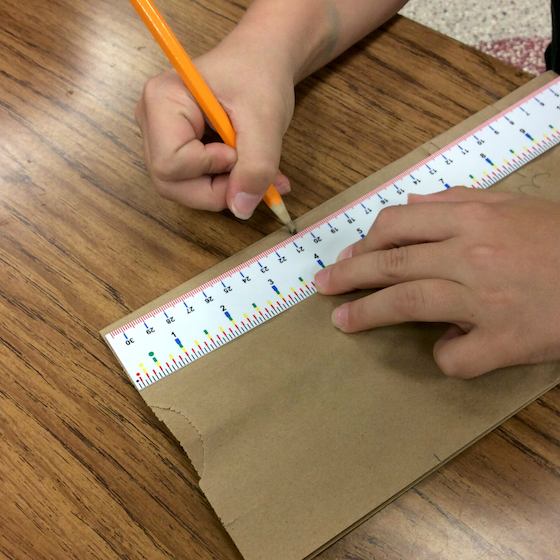
“I’m going to show you all how we can use math measurements in art.” No other phrase takes my students’ mood from anticipation to dread faster. On the other hand, that very same phrase has the general education teachers and administrators in my building shouting for joy.
Although we somehow always make it through projects requiring rulers semi-successfully, I always have some students that struggle no matter what. That is, until recently. Enter Gretchen McCormick and her brilliant invention the Measure by Color Ruler.
Yes, you read that right, Measure by COLOR. We know art teachers go wild over anything color coded, and this tool is no different. Read on to see why you should definitely be adding the Measure by Color Ruler to your classroom and singing its praises to the rest of your staff as well.
How does it work?
Gretchen’s dad is a high school art teacher and she herself has an elementary ed degree. While in one of her undergrad teaching classes, she found it difficult to get students to understand that 1/4” marks on the ruler were also 1/2”, 3/4” and 1” lines. As Gretchen tells it, “I quickly improvised and used 5 different colored markers to identify the measurement increments on a standard wooden ruler.” After the lesson was reintroduced, the students caught on much more quickly. Genius, right?
The secret to the Measure by Color Ruler is this color coding. As you can see in the video below, each ruler measurement is assigned a different color. Red for 1/8”, yellow for 1/4”, Green for 1/2” and Blue for 1”. If students need to measure 3 inches, they simply count 3 blue dots. “This ruler takes away the barriers of interpretation,” Gretchen told me.
http://youtu.be/l7SjYa8bm88
Because students are able to measure quickly and easily, the ruler saves a TON of class time that’s usually spent explaining, circling the room and correcting mistakes.
Classroom Application

As I said, this tool turned out to be a fantastic addition to my art room. Each year, I teach my third-grade students this lesson, but there are always students that struggle measuring correctly.
This year, I tried it with the Measure by Color Ruler. I was interested to see if it boosted some of my students’ confidence. I was not disappointed!
What really caught me off guard was how fast the students using the Measure by Color Rulers were able to finish one measurement and be ready to move on to the next. In years past, I would make several passes around the room making sure we were all on track. This year, though, I only had to walk around the room once to make sure everyone was doing okay.
The only issue that came up was that one of my colorblind students couldn’t differentiate between the colors. However, having a family member with colorblindness made Gretchen think ahead on this issue. She made each color a different width to solve the problem. In addition, the ruler has text in English and Spanish. All of these details make the ruler a great fit for all of your students. Which brings me to my next point: The Measure by Color Ruler is for all teachers!
Share the Love
Although art teachers may naturally be drawn to this colorful ruler first, it’s a great fit for any classroom. Letting other teachers in on this secret will help foster working relationships and help better equip students in all classrooms in your school to learn to measure more effectively. I wholeheartedly recommend it! If you’re interested, Nasco Arts and Crafts is the place to get them!
Thanks so much to Gretchen for creating such an innovative product and taking the time to talk with AOE.
Have you ever used Measure By Color? What did you think about it?
What tricks do you have for helping students understand ruler measurements?
Magazine articles and podcasts are opinions of professional education contributors and do not necessarily represent the position of the Art of Education University (AOEU) or its academic offerings. Contributors use terms in the way they are most often talked about in the scope of their educational experiences.




